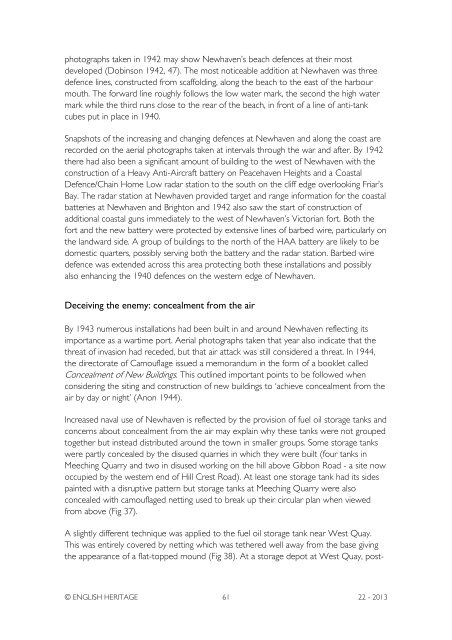Aerial Investigation and Mapping Report - English Heritage
Aerial Investigation and Mapping Report - English Heritage
Aerial Investigation and Mapping Report - English Heritage
Create successful ePaper yourself
Turn your PDF publications into a flip-book with our unique Google optimized e-Paper software.
photographs taken in 1942 may show Newhaven’s beach defences at their mostdeveloped (Dobinson 1942, 47). The most noticeable addition at Newhaven was threedefence lines, constructed from scaffolding, along the beach to the east of the harbourmouth. The forward line roughly follows the low water mark, the second the high watermark while the third runs close to the rear of the beach, in front of a line of anti-tankcubes put in place in 1940.Snapshots of the increasing <strong>and</strong> changing defences at Newhaven <strong>and</strong> along the coast arerecorded on the aerial photographs taken at intervals through the war <strong>and</strong> after. By 1942there had also been a significant amount of building to the west of Newhaven with theconstruction of a Heavy Anti-Aircraft battery on Peacehaven Heights <strong>and</strong> a CoastalDefence/Chain Home Low radar station to the south on the cliff edge overlooking Friar’sBay. The radar station at Newhaven provided target <strong>and</strong> range information for the coastalbatteries at Newhaven <strong>and</strong> Brighton <strong>and</strong> 1942 also saw the start of construction ofadditional coastal guns immediately to the west of Newhaven’s Victorian fort. Both thefort <strong>and</strong> the new battery were protected by extensive lines of barbed wire, particularly onthe l<strong>and</strong>ward side. A group of buildings to the north of the HAA battery are likely to bedomestic quarters, possibly serving both the battery <strong>and</strong> the radar station. Barbed wiredefence was extended across this area protecting both these installations <strong>and</strong> possiblyalso enhancing the 1940 defences on the western edge of Newhaven.Deceiving the enemy: concealment from the airBy 1943 numerous installations had been built in <strong>and</strong> around Newhaven reflecting itsimportance as a wartime port. <strong>Aerial</strong> photographs taken that year also indicate that thethreat of invasion had receded, but that air attack was still considered a threat. In 1944,the directorate of Camouflage issued a memor<strong>and</strong>um in the form of a booklet calledConcealment of New Buildings. This outlined important points to be followed whenconsidering the siting <strong>and</strong> construction of new buildings to ‘achieve concealment from theair by day or night’ (Anon 1944).Increased naval use of Newhaven is reflected by the provision of fuel oil storage tanks <strong>and</strong>concerns about concealment from the air may explain why these tanks were not groupedtogether but instead distributed around the town in smaller groups. Some storage tankswere partly concealed by the disused quarries in which they were built (four tanks inMeeching Quarry <strong>and</strong> two in disused working on the hill above Gibbon Road - a site nowoccupied by the western end of Hill Crest Road). At least one storage tank had its sidespainted with a disruptive pattern but storage tanks at Meeching Quarry were alsoconcealed with camouflaged netting used to break up their circular plan when viewedfrom above (Fig 37).A slightly different technique was applied to the fuel oil storage tank near West Quay.This was entirely covered by netting which was tethered well away from the base givingthe appearance of a flat-topped mound (Fig 38). At a storage depot at West Quay, post-© ENGLISH HERITAGE 61 22 - 2013

















